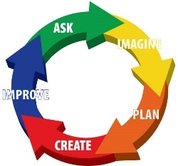 How well do you know the Engineering Design Process (EDP)? How well do your students know it? If you answered “not at all” to either of those questions, think again. You likely follow some of the steps in your everyday activities. The focus of the EDP is problem solving. I’m sure you’ve problem solved already today. Deciding what to wear, which errands to complete, and where to eat are examples of everyday situations where you subconsciously use the EDP. Let’s review the steps to see if you agree.
The Engineering Design Process is something we use more often than we realize. However, many kids today do not have this same skill set and often lack problem-solving skills. So, let’s look at how a Pitsco Maker Space Project can be used to teach the EDP. The KaZoon Kite Maker Project spans all three of our leveled makerspace packages.
Blog re-printed from Pitsco Education Community Blog. Content written by Kristina Davis, Education Program Designer.
2 Comments
Connekt LLC
4/26/2018 02:18:12 am
Its really a good blog on <a href="http://connektllc.com">Mechanical engineering</a>. I appreciate your article. Its important to get mechanical engineering tips. This blog is really helpful to give a light in this issue. So thanks for sharing all that important information.
Reply
10/27/2022 12:20:46 am
Flooding impacts more people globally than any other natural hazard and causes significant damage to property
Reply
Leave a Reply. |
AuthorYou have questions about STEM education? You're not alone! We're here to share ideas and provide thought-provoking commentary. Let us know your thoughts! Sign Up for Email Updates For Email Marketing you can trust. Categories
All
Archives
February 2017
|
- Home
-
K-12
- College
- Industry
- Certifications
-
Partners
- Afinia-3D Printing
- Amatrol-Manufacturing Training Equipment
- Apolo Studios- Welding Simulation
- APT Manufacturing
- Bantam Tools - CNC
- CEF-Custom Educational Furniture
- DAC Worldwide-Manufacturing Equipment
- FANUC-Robotics & CNC
- Greene Manufacturing Inc - Furniture
- Iconic CNC
- Interior Concepts-Furniture
- Levil Technology-CNC
- MSSC Certifications
- MINDS-i Education
- Pitsco Education-STEM
- SimLog-Heavy Equipment Simulation
- Stokes Robotics
- Techno CNC Systems
- Universal Laser Systems
- VictoryXR - Virtual Reality
- WB Mfg - Furniture
- Funding
- Contact
- About
- Home
-
K-12
- College
- Industry
- Certifications
-
Partners
- Afinia-3D Printing
- Amatrol-Manufacturing Training Equipment
- Apolo Studios- Welding Simulation
- APT Manufacturing
- Bantam Tools - CNC
- CEF-Custom Educational Furniture
- DAC Worldwide-Manufacturing Equipment
- FANUC-Robotics & CNC
- Greene Manufacturing Inc - Furniture
- Iconic CNC
- Interior Concepts-Furniture
- Levil Technology-CNC
- MSSC Certifications
- MINDS-i Education
- Pitsco Education-STEM
- SimLog-Heavy Equipment Simulation
- Stokes Robotics
- Techno CNC Systems
- Universal Laser Systems
- VictoryXR - Virtual Reality
- WB Mfg - Furniture
- Funding
- Contact
- About

 RSS Feed
RSS Feed
